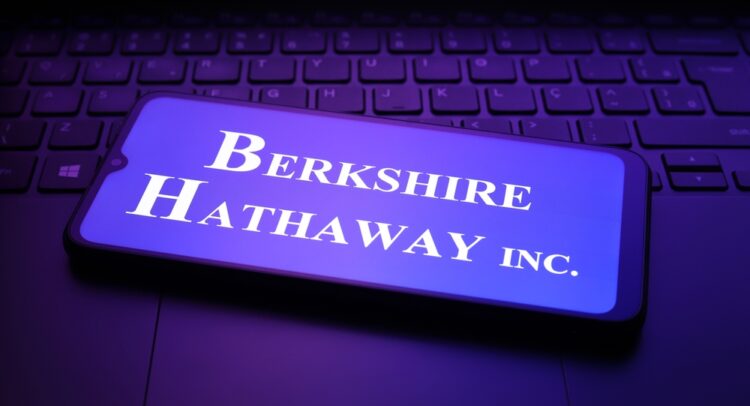Warren Buffett’s announcement that he would step down as CEO of Berkshire Hathaway (BRK.B) marked a moment of reflection. The iconic conglomerate, led by possibly one of the greatest investors in market history, transformed a $10,000 investment in 1965 into more than $550 million, and now finds itself at a pivotal crossroads.
Elevate Your Investing Strategy:
- Take advantage of TipRanks Premium at 50% off! Unlock powerful investing tools, advanced data, and expert analyst insights to help you invest with confidence.
Under Buffett’s watchful eye, the company became a symbol of disciplined investing, wise decision-making, and a pinch of humility. With Greg Abel set to take over, I have reason to be modestly bullish regarding Berkshire’s future outlook, regardless of its low alpha prospects due to minimal AI exposure.
Abel inherits a strong, diversified empire founded upon consistent compounding, intelligent investing, and ample cash for strategic value investing. Yet, he also has key decisions to make that may chart Berkshire’s direction, particularly regarding technology and innovation.
Buffett’s Legacy and Lessons Learned
Warren Buffett’s track record as an investor is unmatched—19.8% yearly returns since 1965, or nearly twice the S&P 500’s (SPY) performance during that time. This resulted from wiser capital allocation, time-tested value investing fundamentals, and remarkable patience to ride out the peaks and troughs.
For example, consider Berkshire’s Coca-Cola (KO) investment: Buffett spent approximately $1.3 billion in the late 1980s, and today it’s valued at about $25 billion, excluding dividends. Similarly, Buffett’s bold entry into Apple (AAPL) in 2016, at $31 billion initially, ballooned to around $174 billion at its peak. There’s also the underrated, but wonderfully successful See’s Candies, acquired for just $25 million in 1972, which has since given back profits over 60 times that amount.

But even the Oracle of Omaha makes mistakes. Consider Dexter Shoe. Buffett invested $433 million, and when it failed, he lamented paying in Berkshire shares—a mistake worth billions of dollars in present value. And then there’s Kraft Heinz (KHC). Overpaying resulted in a steep multi-billion-dollar loss.
There are also the could-have-beens: Buffett laments missing out on enormous gains by steering clear of Google (GOOGL), Amazon (AMZN), and Microsoft (MSFT) during their initial growth spurts. That said, he recently bought a stake in Amazon. These errors serve as reminders that even the best investors are not flawless, but rather lifelong learning machines. Moreover, the missed tech opportunities are a case in point that Berkshire might not be as prepared for the AI age as its shareholders might hope.
At this year’s annual meeting in Omaha, Nebraska—colloquially known as the “Woodstock for Capitalists”—the firm released 5,000 copies of a limited-edition book, 60 Years of Berkshire Hathaway, commemorating Warren Buffett’s tenure as CEO.

Berkshire Hathaway in Contrast
Over the past decade, Berkshire returns have tracked the S&P 500 closely with a CAGR of around 13%. It hasn’t outperformed the tech-heavy Nasdaq, which returned approximately 17%, but the more conservative approach means it holds up during downturns.
In 2022, when the Nasdaq fell 33%, Berkshire gained 4%. This stability is appealing if you’d prefer to skip the roller-coaster ride of timing tech returns. Berkshire essentially offers growth and capital preservation with much less volatility and shareholder anxiety.
As a result, Berkshire’s limited exposure to bleeding-edge tech is reassuring and troubling. Its largest single tech holding is Apple, which accounts for about 28% of the portfolio. Outside of Apple, Berkshire owns small positions in Amazon (AMZN), Snowflake (SNOW), and Nu Holdings (NU)—but these are very small percentages of the portfolio. It also has a very successful stake in Chinese EV giant BYD (BYDDF). But in an increasingly AI-driven, cloud-based, and innovation-led world, Berkshire’s primary investments in financial services, consumer staples, and energy appear somewhat behind the times.
Future BRK.B Forecasts Lean Bullish
Looking ahead, I see three scenarios for Berkshire Hathaway through 2035. In a world of stable growth, Berkshire probably keeps pace with the market, earning somewhere near 8% per year. Abel would simply follow Buffett’s legacy, riding Apple’s ongoing strength while Berkshire’s other businesses plod along predictably. Investors receive good growth with reduced risk—fine, but not spectacular.
In a tech-driven boom, where innovation and AI reign, Berkshire could underperform dramatically, perhaps earning just 5-6% annually as its old-economy stakes lag. Abel would face pressure to make a dramatic tilt towards tech or endure underperformance. Those investors with a significant appetite for growth would be better off in tech-heavy funds, so Berkshire would be a defensive play.

But if markets move back towards value amid high inflation or recession, Berkshire shines. Abel would be well-placed to exploit Berkshire’s vast cash pile, snapping up bargains in falling markets, just as Buffett has been doing in past crises. Berkshire could quite easily outperform, possibly generating something like 10% a year. Investors seeking safety and upside in turbulent times would be especially drawn to Berkshire.
What is the Target Price for BRK.B Stock?
On Wall Street, Berkshire Hathaway stock carries a Moderate Buy consensus rating, based on two Buys, one Hold, and zero Sells. The average BRK.B stock price target is $544, indicating an 8% upside potential over the next 12 months. This outlines the moderate return prospects I alluded to, but still shows capital preservation power.

Berkshire Remains a Popular Defensive Holding
For long-term, buy-and-hold retail investors, Berkshire Hathaway remains a strong core holding. While it may lack the hypergrowth appeal of tech-centric peers, its diversified business model, substantial cash reserves, and disciplined investment philosophy offer stability, steady compounding, and robust downside protection.
As Greg Abel steps into the leadership role, he faces the challenge of balancing innovation with Berkshire’s long-standing principles. Nonetheless, the company’s financial strength and operational resilience position it well across varying market conditions.
Berkshire may not be the flashiest name in the market, but for investors seeking low-volatility, long-term wealth accumulation, it offers a compelling blend of stability and prudent growth. I remain optimistic that its foundational strengths and conservative capital strategy will serve it well in the post-Buffett era.


















